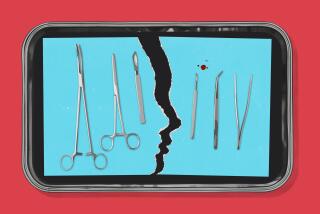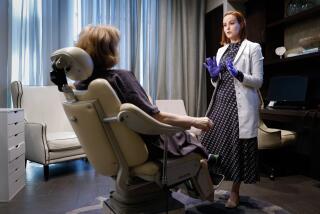Cosmetic Surgery Helps in a Competitive World
- Share via
Cosmetic surgery for male business executives in mid-life is becoming somewhat common in Orange County. It is even beginning to emerge from the closet. More and more men are willing to discuss their operations openly.
I got this information the other day from a man who knows--Dr. Eugene D. Elliott, diplomate American Board of Plastic and Reconstructive Surgery, whose office is in Fountain Valley.
It used to be that a man who had his face lifted was in show business, or was exceedingly vain, but male executives are having it done today for largely another reason, he said.
“This is a highly competitive world. A tired-out look, bags under the eyes, sagging chin can give the appearance that the executive is not on the ball. Their main goal is to look rested and competitive.”
Elliott, a youthful appearing 36, refuses to operate on anybody whose personal conception of the way he thinks he ought to look after cosmetic surgery exceeds reality. There are finite limitations to rebuilding a face, and Elliott possesses a highly educated sense of the limits of cosmetic and reconstructive surgery.
He has the trained ability to visualize in the third dimension, like a sculptor. In fact, he is a sculptor--and a painter--and a draughtsman. He entered plastic and reconstructive surgery from the art field, after he was art director of McCann-Erickson and later Ogilvy & Mather, prominent New York advertising firms. He recalls with a chuckle that he conceived the original pickpocket commercial of Karl Malden’s for American Express.
Although he was educated in the fields of fine and commercial art and in literature at Bard College, the art field began to pale during the Vietnam War. While at Ogilvy & Mather, he was assigned to work with Kingman Brewster, then president of Yale, on a national advertising campaign to “unsell the war.” This appealed to him as something important to do, but disillusionment set in when it became evident that none of the national networks had any intention of cooperating.
Elliott’s brother, a successful plastic surgeon, suggested he could well use his aesthetic judgment and art skills and at the same time benefit mankind by becoming a doctor and ultimately specializing in plastic and reconstructive surgery. Elliott followed the advice and studied at the University of Rochester and Stanford University, where he interned. Then he was one of only four out of 700 applicants who were accepted at Stanford in his specialty.
It is in the area of reconstructive surgery, particularly when a patient is disfigured in an accident, that Elliot’s ability to perceive in the third dimension and his art training becomes valuable. Sculptures and drawings of the way a patient should look after surgery are important reconstructive tools for Elliott, not to mention their help to patients and their families. Unfortunately, according to Elliott, the practice of plastic surgery, owing to the growing popularity of cosmetic surgery, is attracting some questionable practitioners. There are some doctors with general medical degrees who have become self-styled plastic and reconstructive surgery specialists, with little or no training in the specialty. Some of these may attempt to meet a patient’s unrealistic ideas of appearance and then botch the job, he said.
His advice for prospective patients is to make sure that the doctor of choice is a diplomate of the American Board of Plastic and Reconstructive surgery. Claims of some other “board certification” should not be acceptable, he warned.
I was amused by Elliott’s reaction to my comment about my own decidedly unrested and uncompetitive old face in the bathroom mirror of a morning. Clearly, he was reluctant to consider me as a new patient.
“As I was saying, there are some people who harbor unrealistic expectations.” But maybe, just maybe, he could do something about my bird legs.


